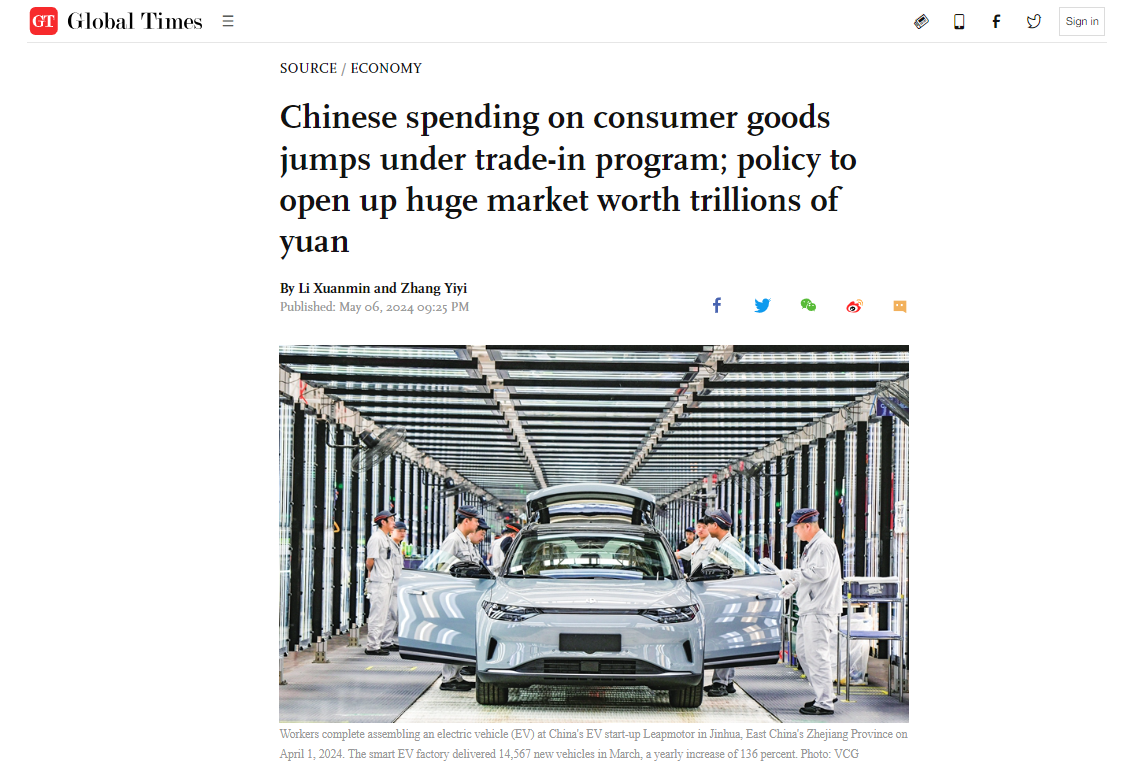LATEST INSIGHTS
Your Present Location: LATEST INSIGHTSHe Weiwen: Chinese spending on consumer goods jumps under trade-in program; policy to open up huge market worth trillions of yuan
Source: GT Published: 2024-05-13

The National Development and Reform Commission (NDRC), China's top economic planner, held a symposium in recent days with representatives of private companies on trade-ins of large-scale equipment and consumer products, according to a post seen on Monday on the NDRC's WeChat account.
The meeting added to a series of moves by the Chinese central government and departments to promote the upgrading of consumer items. Since the sweeping plan to shore up consumption was launched in March, spending on consumer goods has jumped, data from the country's e-commerce platforms showed. Sales of some items doubled during the just-concluded five-day May Day holidays that ended on Sunday.
Observers said that the spending spree presages a stepped-up recovery in the consumer market, which only grew mildly in the first quarter. Analysts expect that the trade-in fueled consumption could open up a huge market worth trillions of yuan throughout the year. They expect retail sales to grow more than 5 percent in 2024, helping the economy to navigate through rising headwinds and meet the GDP growth target of about 5 percent.
Private firms that took part in the NDRC meeting included battery maker Tianneng Group, equipment manufacturer Xizi UHC and Canny Elevator. Company attendees highlighted the huge market potential of equipment upgrades, which could help them improve their technology and competitiveness. Upgrades could also improve living standards and enhance the standards of public services such as education and healthcare, the NDRC post noted.
The meeting aligns with an overall plan the State Council, the country's cabinet, released in March, which aims to promote the large-scale renewal of equipment and trade-ins of consumer goods.
Since then, various Chinese departments have announced trade-in stimulus plans for different consumer goods, including vehicles, home appliances, industrial equipment and home decoration goods. The overarching plan has also been endorsed by dozens of localities such as Shanghai, East China's Zhejiang and Shandong provinces, and Central China's Henan Province, which issued corresponding detailed measures to fast-track the implementation of the plan.
These concrete efforts have borne fruit, the Global Times learned.
A spokesperson of e-commerce platform Suning told the Global Times on Monday that the new plan has 'largely unleashed consumer vitality in the home appliance market.'
The platform provided consumers who joined the trade-in plan during the May Day holidays with up to 5,000 yuan ($693.73) in subsidies and 10 percent price discounts on new consumer items.
According to data provided by Suning, sales of green, energy-saving appliances more than doubled during the May Day holidays thanks to the trade-in policy, while orders for home appliance renovations and replacements expanded by 96 percent year-on-year. Orders for replacement air conditioners jumped by 78 percent.
Another Chinese e-commerce platform, JD.com Inc, has not released its to-date sales data. But according to a statement the company sent to the Global Times on Monday, it is estimated that more than 20 million users will participate in the company's home appliance and home furnishings trade-in program, with more than 30 million units of used goods being recycled so far in 2024.
A number of Chinese vehicle makers including BYD, Xpeng and Nio have also joined the trade-in program, providing subsidies for consumers who scrapped old cars in exchange for new-energy vehicles, the Securities Times reported on Monday.
Observers said that consumer goods such as home appliances and vehicles are the leaders in taking advantage of the trade-in policy. The effects of the policy will gradually expand to large commodities such as industrial products and large-scale equipment.
He Weiwen, a senior fellow at the Center for China and Globalization, told the Global Times on Monday that the impact of the trade-in policy will be more apparent in the second half of the year.
'It is estimated that the policy could drive China's GDP by less than 1 percent in 2024, which is quite valuable,' he said, calling for more substantial inputs from the government and companies to consolidate the result.
Analysts pointed out an imbalance in the recovery of China's consumption, as services consumption has been picking up while that of consumer goods remains 'modest.'
As the trade-in program is set to inject new vitality into goods consumption, He Weiwen projected that retail sales will accelerate in the second quarter and expand by 5-7 percent this year.
Retail sales rose 4.7 percent year-on-year to 12.03 trillion yuan in the first quarter, National Bureau of Statistics data showed.
Key Words: He Weiwen, China, consumer goods























































































 京公网安备 11010802037854号
京公网安备 11010802037854号





